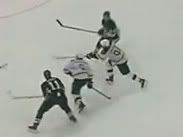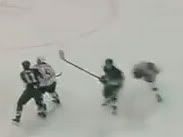 The Post-Olympic Syndrome of head shots and controversial hits in the game of hockey these days kind of make me sad. On Thursday night, Brent Seabrook of the Chicago Blackhawks managed to tag Corey Perry of the Anaheim Ducks with a questionable hit and then was hit himself by Perry's teammate, James Wisniewski, in retaliation of the initial hit.
The Post-Olympic Syndrome of head shots and controversial hits in the game of hockey these days kind of make me sad. On Thursday night, Brent Seabrook of the Chicago Blackhawks managed to tag Corey Perry of the Anaheim Ducks with a questionable hit and then was hit himself by Perry's teammate, James Wisniewski, in retaliation of the initial hit.The way I saw it initially was that Perry got rocked pretty good with no penalty call, the play managed to continue with the puck staying in the Blackhawks defensive zone where the hit took place, and there was a charging call of a hit laid down to retaliate.
First of all, I don't think Wisniewski is in the wrong for wanting to take care of business, helping to police the situation on the ice, especially if the officials are not going to do it themselves. In a real time situation on the ice, I would have to imagine that the play looked pretty dirty from every angle conceivable, except for maybe the angles that the officials had on the play.
Without any justification from the officials, the fans and media are left to guess and speculate as to what happened on the ice there. I think this is one of the bigger issues at hand for the NHL, but really, everyone loves to have their guess and criticize based on that guess, that it really doesn't seem to be much of an issue in the end.
Sorry, I veered off a little bit there. A lot of the fights that happen after "clean hits" are easy to judge when we have the ability to replay it over and over again, while a lot of the players don't have that luxury and with the speed of the game the way it is, I would have to think that some of these players have to guess as to whether or not to stand up for their fallen teammates. This is really the reason why I'm okay with fights after clean hits, because I'm not sure if I'm able to judge the play when I'm concentrating on the play itself on the ice. So, saying that hits in real time on the ice are likely incredibly hard to judge and when a guy like Wisniewski sees Perry on the ice after a questionable hit, we probably shouldn't be surprised when he decides to hunt down Seabrook, either from comments from the bench or his own justification.
Now, the justification for the hit itself is very questionable, which leads to all sorts of different questions that are not likely asked of the players involved. My first question to Wisniewski would be something along the lines of "does the instigator penalty run through your mind when charging after Seabrook like you did?"
If Wisniewski was to have dropped his gloves and started to pummel Seabrook for his hit, he would have received a 2-minute minor for instigating, 5 minutes for fighting and a 10-minute misconduct. Instead, he received a 2-minute minor for charging, which was the correct call on the play and then was credited with a fight with Duncan Keith, without any misconduct penalty. Wisniewski also had to step-up and defend himself again near the end of the game, but at least he was around to do so, which he may not have had the option to do, which would have been at the discretion of the referees on the ice.
In some recent quotes, which have been echoed many times since the integration of the instigator rule in hockey, it's being blamed for some of these controversial incidents that involve headshots these days. I honestly believe that this is another one of those incidents, which may have been avoided if the instigator rule was dropped. A lot of the headhunting, like what Seabrook (in my opinion) was doing to Perry would have been avoided if there was players that could police themselves and patrol the ice on a regular basis. Furthermore, I would think that if Wisniewski could have solved the matter by dropping the gloves and starting to pummel Seabrook without fear of an extra 10-minute misconduct (or possibly a game misconduct), we wouldn't have seen the decision to charge at Seabrook, thus causing a high hit.
I don't know how much more you can say about this, its really becoming quite tiresome. I couldn't honestly say if this new headshot rule is going to solve anything, because there is still going to be a lot of players taking exception to all sorts of different hits out there, but in my mind, I'll side with the players that are defending their guys and standing up for them.


